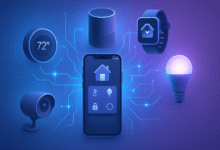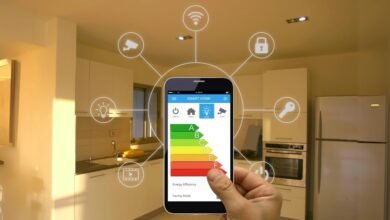Wearable IoT Devices and Health Tracking: What German Users Need to Know
Wearable IoT (Internet of Things) devices are electronic gadgets worn on the body that collect and transmit health-related data through internet connectivity.

In Germany, the integration of wearable IoT devices into daily life is revolutionizing personal health management. These devices, ranging from smartwatches to advanced biosensors, offer real-time health monitoring, empowering users to take proactive steps towards well-being. As the demand for personalized healthcare grows, understanding the capabilities and considerations of these devices becomes essential for German consumers.
Understanding Wearable IoT Devices
Wearable IoT (Internet of Things) devices are electronic gadgets worn on the body that collect and transmit health-related data through internet connectivity. Common examples include
-
Smartwatches: Monitor heart rate, sleep patterns, and physical activity.
-
Fitness Bands: Track steps, calories burned, and exercise routines.
-
Smart Rings: Measure sleep quality, heart rate variability, and body temperature.
-
Smart Clothing: Embedded with sensors to monitor physiological metrics like respiration and muscle activity.
These devices utilize sensors and wireless communication to provide continuous health insights, aiding in early detection of potential health issues.
The German Market Landscape
Germany’s wearable medical devices market is experiencing significant growth. In 2024, the market generated approximately USD 3.48 billion in revenue and is projected to reach USD 7.35 billion by 2030, growing at a CAGR of 13.4% from 2025 to 2030. Chronic disease management emerged as the largest revenue-generating application in 2024, while remote patient monitoring is the fastest-growing segment during the forecast period.
This growth is driven by increasing health consciousness among consumers and the adoption of digital health solutions.
Benefits of Wearable IoT Devices for Health Tracking
1. Real-Time Health Monitoring
Wearable IoT devices provide continuous monitoring of vital signs such as heart rate, blood pressure, and oxygen saturation. This real-time data enables users to detect anomalies promptly and seek medical attention when necessary.
2. Chronic Disease Management
For individuals with chronic conditions like diabetes or hypertension, these devices offer tools to monitor glucose levels, blood pressure, and medication adherence, facilitating better disease management.
3. Enhanced Physical Activity Tracking
Fitness enthusiasts benefit from detailed tracking of workouts, steps, and calories burned, allowing for personalized fitness plans and goal setting.
4. Improved Sleep Quality
Devices that monitor sleep patterns help users understand their sleep cycles, identify disturbances, and implement changes to improve sleep quality.
5. Stress and Mental Health Monitoring
Some wearables assess stress levels through heart rate variability and provide relaxation techniques, contributing to better mental health management.
Popular Wearable IoT Devices in Germany
Several wearable devices have gained popularity among German consumers:
-
Apple Watch Series: Offers comprehensive health tracking features, including ECG and blood oxygen monitoring.
-
Fitbit Charge Series: Known for its user-friendly interface and accurate fitness tracking.
-
Garmin Forerunner Series: Preferred by athletes for advanced performance metrics.
-
Oura Ring: A discreet smart ring focusing on sleep and recovery tracking.
-
Withings ScanWatch: Combines traditional watch design with medical-grade health monitoring features.
Data Privacy and Security Considerations
With the collection of sensitive health data, privacy and security are paramount. German users should be aware of the following:
-
Compliance with GDPR: Ensure that the device manufacturer complies with the General Data Protection Regulation, safeguarding personal data.
-
Data Encryption: Opt for devices that encrypt data during transmission and storage.
-
User Consent: Be cautious of apps that share data with third parties without explicit consent.
-
Regular Updates: Keep device firmware and applications updated to protect against vulnerabilities.
Integration with Healthcare Systems
Germany’s healthcare system is increasingly integrating wearable data into patient care:
-
Electronic Health Records (EHRs): Some healthcare providers incorporate wearable data into EHRs for a comprehensive view of patient health.
-
Telemedicine: Wearables facilitate remote consultations by providing doctors with real-time health data.
-
Preventive Care: Continuous monitoring aids in early detection of health issues, enabling preventive interventions.
Challenges and Considerations
Despite the benefits, users should consider the following challenges:
-
Accuracy of Data: Not all devices provide medical-grade accuracy; consult healthcare professionals for critical health decisions.
-
Battery Life: Frequent charging may be inconvenient; consider devices with longer battery life.
-
Cost: High-end devices can be expensive; evaluate features against personal health needs.
-
User Engagement: Consistent use is essential for meaningful insights; choose devices that align with lifestyle and preferences.
Future Trends in Wearable Health Technology
The wearable technology landscape is evolving, with emerging trends including
-
Advanced Biosensors: Development of sensors capable of monitoring a broader range of health metrics.
-
Artificial Intelligence Integration: AI algorithms providing personalized health insights and predictions.
-
Expanded Healthcare Integration: Deeper integration with healthcare systems for real-time monitoring and intervention.
-
Sustainable Designs: Focus on eco-friendly materials and energy-efficient devices.
Conclusion
Wearable IoT devices are transforming personal health management in Germany, offering tools for proactive health monitoring and disease management. As technology advances, these devices will become increasingly integral to healthcare, emphasizing the importance of informed choices regarding device selection, data privacy, and integration with medical care.











